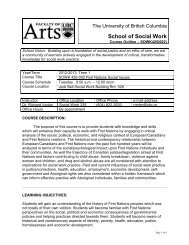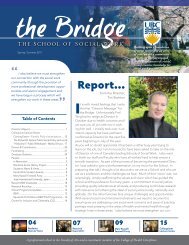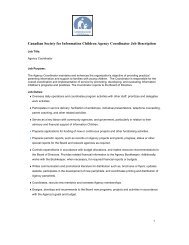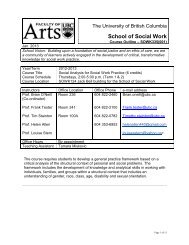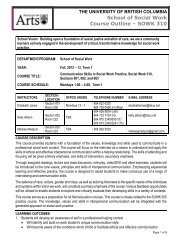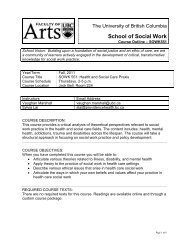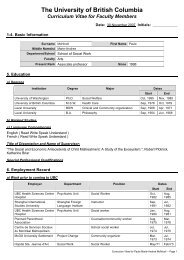Equity Case Studies Report - School of Social Work - University of ...
Equity Case Studies Report - School of Social Work - University of ...
Equity Case Studies Report - School of Social Work - University of ...
Create successful ePaper yourself
Turn your PDF publications into a flip-book with our unique Google optimized e-Paper software.
UBC school <strong>of</strong> social work equity and diversity strategic plan: A compilation <strong>of</strong> case studies 10<br />
include Faculty members serving on community boards, delivering guest lectures at community<br />
functions, and conducting joint research initiatives (MacDonald et al., 2003).<br />
Leadership, Governance, and Strategic Commitment<br />
As previously mentioned, a task force (Internal Minorities Task Force) was formed in<br />
1973 to address equity issues at the <strong>School</strong> <strong>of</strong> <strong>Social</strong> <strong>Work</strong>, which evolved into a standing<br />
committee in 1983, called the Committee on Racial and Ethnic Affairs, and is now called the<br />
Diversity and <strong>Equity</strong> Committee. When it was still the Committee on Racial and Ethnic Affairs,<br />
it received recognition from the Nova Scotia Human Rights Commission for its sponsorship <strong>of</strong><br />
an affirmative action program (MacDonald et al., 2003). The mandate <strong>of</strong> the committee<br />
includes:<br />
Addressing issues such as recruitment <strong>of</strong> applicants from designated groups, overseeing<br />
and promoting the affirmative action policy, nurturing community links, and supporting<br />
students. Status as a standing committee entails formal recognition within the<br />
governance document; designated representation on all decision-making committees;<br />
workload recognition for faculty participation; involvement in a myriad <strong>of</strong> school<br />
processes such as recruitment, admissions, orientation, curricular review, program<br />
development, and organizing and sponsoring conferences; and representation on<br />
university-wide committees. (MacDonald et al., 2003, p. 473)<br />
In addition, although it does not have formal recognition in the governance document, there is a<br />
Gay Lesbian Bisexual Transgender (GLBT) Caucus, initiated in 1998 by students and faculty.<br />
The GLBT Caucus provides support to Lesbian, Gay, Bisexual, Transgendered, Two Spirited,<br />
Queer, and Intersex (LGBTTQI) students and examines areas within the <strong>School</strong> that are<br />
homophobic or heterosexist in design or practice. For example, in 1999, there was a revision <strong>of</strong>



